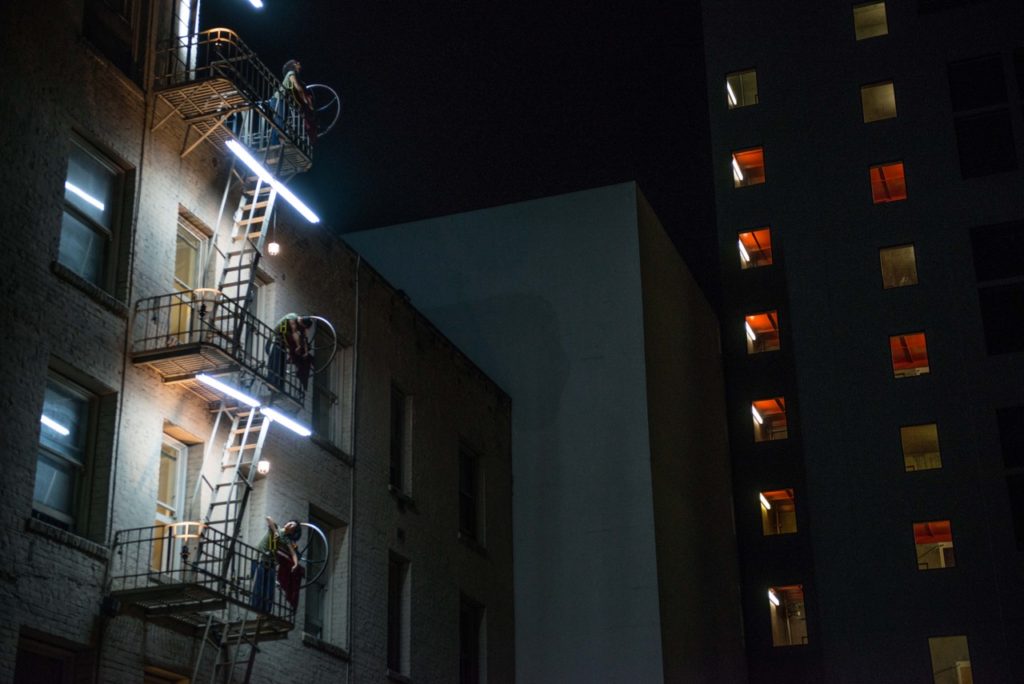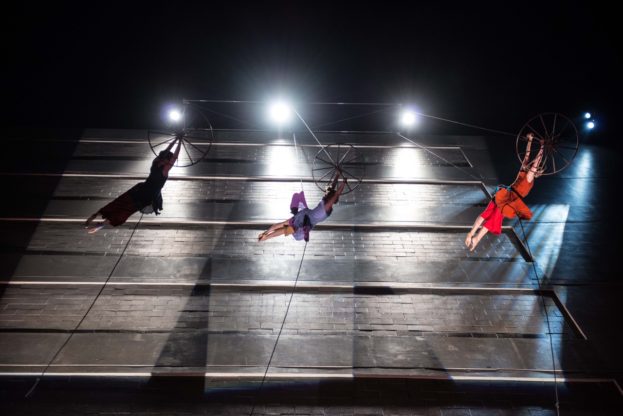
Being asked to reflect on 20 years of dance making is daunting. So I have decided to write in the second person. Adrienne Rich, one of my favorite poets and a crucial 20th century political thinker, wrote some of her strongest poems in this narrative voice. I choose to honor her influence on me in this way, with the additional preface that I am truly a Bay Area artist, self- taught and supported by the amazing choreographers who live here, and who have generously allowed me to learn from them.
_____________
You wake up in the middle of the night with a new idea for how to climb something, or how to traverse something, or how to thrash around without falling.
You try to get it down on paper before sleep comes back to claim you.
You wake up tired, but with a little jewel of choreographic know-how recorded on the skinny notebook by your bed.
You think about the big world.
You pine for things to get better. For the artists. For the down and out. For the women raising kids on their own. For the women who don’t have a house to live in, or even a room. For the women fighting their way to a decent paycheck. A fair paycheck. A paycheck as fair as men get.
You think about the women working two jobs and their kids who’ve never been able to afford a dance class.
You try to do something about that. You teach year after year.
You bring magic and imagination and flight to the kids who have hard stories at home.
You want to make things.
You want to make things that are big and bold and impossible to ignore.
You want to animate the city block. The four buildings that frame an alley. The floor to ceiling possibilities of a warehouse. All 6,000 feet of it.
You want to harness what is wild in you and tame it into something approachable. Something to bite into and taste sweetness. And maybe a little bitterness.
You want to conjure the good kind of fear. The roller coaster kind of fear that has a soft landing.
You want to figure out how to endure the bad days. The three grant rejections in a row sitting in your inbox. The financial statement that doesn’t quite end in the black. The failure to do what you set out to do. And the recovery from that failure. The kind that makes the next project something both indomitable and completely necessary to embark on.
You want to be in love. So you gather the dancers around and love them through every moment of the making.
You love their sweat, their exquisite flips and turns, their laughter as they crash into the wall, and try it over again.
You love their bodies—their long limbs, open throats, abdominals that twist in space and hold onto flight just a bit longer than you thought was possible.
You love that your ideas can flourish in their bodies, because they know how to listen to you. And to their own artistic wisdom.
You seek out a posse of women who make music. At first it’s one or two. Now there are half a dozen. You are proud to bring their music out into the world. But selfish too. Your work is stronger because it is wrapped in the wisdom of these women who compose.
You’ve put twenty years in, and hope there will be twenty more. You relish artistic middle age. How it lets you see that you’ve stuck to something, but also that you are not nished yet. That you still have something
to say.
You scheme for the project happening now, and next month, and next year and the year after that. Your vision is endless.
You pray that your fundraising abilities can keep up with your ambition.
You mourn the inevitable life cycle of your dancers. When they decide to become realtors, or go off to grad school, or take time out to become mothers, or join Cirque du Soleil.
You celebrate big when they decide to come back to you, even when the money sucks and the rehearsals put them square in the middle of unkempt streets. Where needles, and shit and broken glass collide with their skinny black sneakers, as they try to land on the wall again, gracefully.
You grapple with the news.
You seek out Cornel West. Rebecca Solnit. The explosion of young women blogging.
You get the Sunday New York Times and it takes you a week to get through it.
You savor the Arts page especially, and have imaginary debates with the Op Ed writers.
You covet the words that Amy Goodman delivers each morning. She is your best fact check for what is really going on in the world and why.
Your dances come from paying attention to the news. They start with nagging discomfort. Usually it’s subtle. Usually it takes a while to connect the dots between a need that speaks to you, and a place you know in the city, and how you can animate that place.
After 20 years you feel like you are done with the confines of the theater. Not to watch other people’s work, you still love that, but in your own dance making. The pull of space off the beaten track is just too strong.

You believe in democracy. Equal access.
You believe in the power of art to transform. And so you make your dances in the street, or above it.
You try to level the playing field for whose spirit gets to soar, or be fed, because of a piece of art.
Lately you think about silence. Not the top of the mountain at sunset or sweet night in the forest kind of stillness. But the not speaking up. Or speaking, only to be disbelieved. Belittled. You reach back into history to hear stories of forced silence. Silenced to death.
You research the silencing of young women written about in ballads.
You think about how silencing as a verb has changed so much. How language has changed to support women more. How terms like “sexual harassment” and “rape culture” didn’t exist until recently. How they gift you with more power to make an end run around silence. And how the gift of these words is not yet enough.
You think about how all these years of dance making are your antidote to silence. To unwanted force, and silence. The summer coach in your 15th year, the guy in the freshman dorm, the boss you had to avoid being alone with.
You think about your lifetime’s accumulation of gendered silence.
Sometimes it’s nuanced.
Sometimes it claws away at your dignity.
Sometimes it punches you in the gut.
How ordinary you are for it.
How every woman you know, and so many girls, too, share your stories.
You tumble into this next round of dance making.
How it’s another try, another chance to float an idea into three dimensions.
How, with this next dance, you are trying again to drive forward.
To change your slim corner of the world.
To launch.


